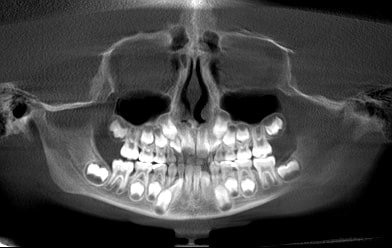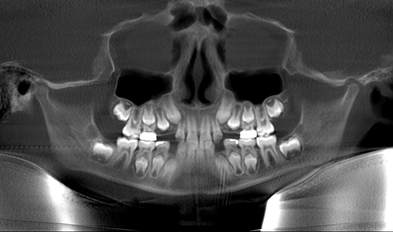Ectopic teeth in a smile and in orthodonticsFor a patient whose teeth are ectopic - out of place - it is distressing. A child will often say, “I don’t like my fangs.” And, if the teeth do not show up, are ectopic and unerupted, it is distressing to have spaces in your smile. It is also distressing for you, wanting to be efficient and effective in helping create an even more beautiful smile. It is distressing in planning and carrying out your orthodontic mechanics in an often difficult situation with potential for negative sequelae. IF, and that is, IF, you see the child early enough, there is a MOST HELPFUL answer to reducing the treatment time, the risk of sequelae, and improving the smile earlier on. It is simply, clearing the path of eruption. While the scholarly articles about this topic are many, and great academics like Ericson and Kurol have written excellently, the bottom line is that the first and most important treatment/prevention is to clear the path. As Fox and Fletcher wrote in the British Dental Journal, “ Late detection of palatal canines may have treatment implications for the patient and medico-legal implications for the dental practitioner.” While it is rewarding to be thought of as the hero who helps a child have the most beautiful smile, it is no fun to be implicated in the parents’ and patient’s thoughts as someone who at worst, “harmed or worsened the smile,” and at best, “didn’t make it better, after all that ‘time and money.’"  Before 'learning the path.' © 2018 Dr Chris Baker Before 'learning the path.' © 2018 Dr Chris Baker Neither is it fun for the parent and patient to be unhappy with their smile, first and foremost, after orthodontic treatment, and neither is it fun for the parent and patient to be unhappy with the provider of orthodontic care. Neither is it fun for the orthodontist to have a treatment plan extended by sometimes - yes - 2-3 years, working to aide eruption of the tooth/teeth, soothe the patient and parent as well as him/herself because everyone wants it to go quicker and easier. Like all of your skills, surely you can learn to utilize, competently choose, plan and intermingle techniques necessary, including exposure, surgical attachment, orthodontic mechanics of wires, chain, forces, biomechanics including anchorage with TAD’s, appliances. And, there will be patients who no one saw early enough to clear the path before the trajectory of the ectopic tooth/teeth was set and difficult. And, there will be patients who BEFORE you even considered how to guide eruption and orthodontically reposition for that patient, there was damage to adjacent tooth roots, occurring as nature’s adverse trajectory triggered the resorption of other permanent tooth roots. And patients whose adverse position is such that the tooth cannot/should not be erupted due to risks. As Jon Kurol states, “The correct development of a stable, functional, and aesthetically acceptable occlusion is an integral component of comprehensive oral health care for all paediatric dental patients. It is the responsibility of the dentist to recognize, diagnose, and manage or refer abnormalities in the developing dentition.” So what to do? Prevent as often and as much as possible. Engage nature and natural eruption. Clear the path as early as is feasible and appropriate. Consider expansion if maxillary teeth are involved. How to identify and diagnose aberrant eruption tracectories, ectopic teeth? Take a panoramic x-ray. Routine pano should be taken when any permanent tooth is erupting into the mouth. That is the time to initially identify possible aberrancies.  Look what 'clearing the path' (no ortho yet) can do! © 2018 Dr Chris Baker Look what 'clearing the path' (no ortho yet) can do! © 2018 Dr Chris Baker Dental panoramic tomograms/ radiographs are widely taken in practice, but not often enough when permanent teeth are just beginning to erupt. Look at the radiograph. Identify each and every permanent tooth’s presence and trajectory. Diagnose aberrancies. Inform the parent. Plan to manage or refer. Every single time. Management at early transitional dentition may include: clearing the path, expansion, monitoring with progress films. Just don’t ignore the aberrancy! Instead, change a life!
0 Comments
Leave a Reply. |
Dr Chris BakerAmerica's most-trusted teacher of orthodontic continuing education, Dr. Chris Baker has practiced and taught for more than 30 years, and is a current or former faculty member of three U.S. dental schools. She is a pediatric dentist, author, blogger, dental practice consultant, and mentor. Dr. Chris is also Past President and Senior Instructor of the American Orthodontic Society. She is based in Texas, USA, but lectures around the world. Categories
All
Archives
July 2024
Text and images
© 2024 Dr Chris Baker |


 RSS Feed
RSS Feed